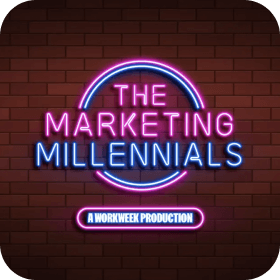Marketing Bestie, I am stoked for you to meet Adam Ryan, CEO of Workweek (yes, THAT Workweek) and 2023 Marketingland KEYNOTE speaker!
There are tons of misconceptions about how to build a media company, but don’t fret, Adam is here to clear them all up.
From breaking down the difference between content marketing and media, to how to turn your content into a revenue arm, today’s email has it all.
Without further adieu, here’s what Adam had to say in his own liiiiightly edited words.
1. Building Cultural Liquidity:
“What great media companies do really well is building cultural liquidity. You build that through trust, entertainment, and connection with your audience.
Ultimately what media organizations are supposed to do, whether within a bigger org or independently, is to create a huge cultural liquidity pool (and have that constantly be refilled with content).
When you’re in a bigger org, like a software company, what you want to do is drain a little bit of the cultural liquidity into your software products. Use that connection and trust to lower your Marketing costs for your bigger products by promoting it in your content.
What you can’t do is drain the entire pool by constantly promoting your products and not refill it.You need to drip it out slowly to help the core business. This creates a flywheel that’s sustainable. Where a lot of people go wrong is they see a huge audience and think, they should just promote all of their products.
And all of a sudden that pool starts to get drained and there’s nothing left because it wasn’t also refilled (SOOOO many brands fall into this habit).
Another way to build cultural liquidity is by NOT having your budgets attached to performance, which might sound counterintuitive to most Marketers. If you’re going to build an actual media organization, it can’t be attached to how many leads you generate or how many courses you sell.
You need an established budget. Identify some of the ways you plan on making money, long term profitable money. You can’t just have the budget attached to a performance metric.
That doesn’t align incentives to build the media arm without draining that cultural liquidity pool.
2. Creating content into a revenue arm:
You need complete focus to make it work.
The biggest hurdle is not recognizing you’re running two different businesses at once (differentiate the two).
A lot of people believe that they can figure out a media business. They’re like, “Oh I run a software company, it’s the same. It’s just like content marketing, we’ll do some ads.”
The reality is they’re totally different skill sets. You need the mentality going in that you have your core business here and your media arm there. It’s like Amazon running a marketplace and Amazon running Amazon web services.
Level up your marketing game
Zero BS. Just fun, unfiltered, industry insights with the game-changers behind some of the coolest companies from around the globe.
No spam. Unsubscribe any time.
Those aren’t remotely related leadership levels for the people that are running the day-to-day of those, because they’re totally different backgrounds and skill sets.
It takes the mindset of understanding you’re running two different business units there.
A problem might arise where someone internally wants to look good and own the media arm because it’s going to lower their CAC. But that person probably doesn’t know how to monetize and if they do, it’s really difficult to manage both those things at once.
So you’d rather have the connective tissue being how you’re promoting your core product and having someone solely focused on that. Keeping monetization separate from the other business.
3. The greatest challenges with building a media arm:
People think it’s just as easy as turning a faucet. They just bought an email list (EWWW), just paid this influencer, etc. Content to commerce is so easy to say, it sounds sexy.
Because of that I think people believe that it’s easy to operate, but that couldn’t be further from the truth.
Media is an extraordinarily hard business to operate. Setting up for sustainable growth is even harder.
People fall into the trap of making moves looking at the next quarter or next year, thinking how they can add x amount of revenue.
But the best media companies are not just 10 years old, they’re 100 years old.
If your mindset is, get that newsletter out there, promote the brand, drive leads, see what we can make this quarter, you’re going to fail sooner or later.
That’s a huge challenge because the people with the capital to buy media companies or build in-house typically are publicly traded companies with an aggressive board and shorter term mindset.
Constantly promoting your product feels like death by 1,000 paper cuts. Over time if you keep doing that, people are like f*ck this, I don’t want to be part of this anymore and they unsubscribe.
But the hurdles don’t stop there, media is getting more competitive. There’s really good content out there across the board. (Everyone has different incentives and motivations behind their content.)
And so you’re entering a market that’s incredibly competitive and needs to be invested in to actually win.
4. A big mistake made in content to commerce:
The biggest mistake folks are going to make when doing a content to commerce strategy is not preparing themselves that it’s not going to sell a bunch immediately.
All of the big companies that have done acquisitions have the media org report to the Head of Marketing. In many ways that’s wrong. There’s a new role that’s coming to fruition, that is more about audience relationship, extending LTV, and creating a moat of the brand.
If you want to do this successfully, you can’t be held accountable just to drive leads. You have to focus on how to make it sustainable long-term because there is no overnight solution to build a media business.
What people are doing now is putting their media organization into the Marketing department.
The issue there is that you’re only going to keep the media organization around if it’s making money for your core business (omg the accuracy).
That’s never the intention of media, that’s what content marketing is for.
5. Media vs Content Marketing:
Media can be content marketing, but the difference is impact and intention.
Great media can have an impact like content marketing. But if you look at media with intention, that is content marketing, and you’re on a slippery slope to zero.
What I like to do is think about our intentions and identify the best possible impact you can have. Great media can have some of the best impact.
If we look at what Barstool did with the Penn acquisition, the impact has been incredibly high, because they’re running that business like a media business.
(Also Adam’s thread on this whole sha-bang was awesome.)
If the intention instead was, they’re only going to get budgets based on sportsbook sign-ups, it would’ve been a rocky road.
Understanding the intention and impact of a media asset is how you can differentiate from content Marketing.
Now really great content marketers have utility that enhances the brand. If there’s really high quality content Marketing it’s just a different lens from media.
If you talk to the best content marketers, they want to have the same goals as a media organization.
They don’t want you to hold them accountable to just leads, because they’re building a brand halo.
There’s definitely a big difference and most of that has to do with audience relationship.
6. “I’d die on this hill”:
We get so caught up in how everything looks but ultimately Marketing is about capturing a-….”
Want to catch the rest of Adam’s wisdom? Claim your pass to Marketingland in Austin, Texas on October 18th!!
Adam will be LIVE on the main stage breaking down all the steps you need to know in order to use media to drive your business forward.
It’s 2023 Marketing Bestie, media is everything.


